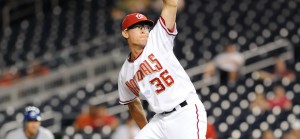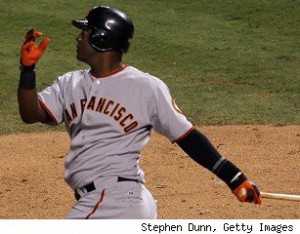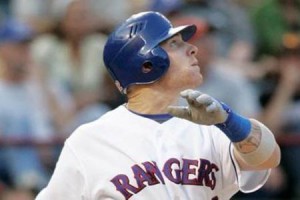Note; stop reading now if you’re one of those people who hate to hear about fantasy teams or analysis of leagues. I understand your point; its kinda like hearing someone go on and on about how their ugly baby just did the cutest thing last week.
I’m in a modified 5×5 yahoo league with 9 other fantasy baseball nuts (of all the fantasy sports, baseball tends to have the biggest nerds I think. Well, perhaps fantasy golf or fantasy nascar). We’ve modified the typical 5×5 categories to add in a 6th category on both sides. We put in OPS on the hitter side and Losses on the pitcher side. We made this change a few years back when one of the players won by churning and burning starting pitchers over and over to stock-pile wins and Ks.
Before going into my draft results and analysis, a few notes on my strategy for picking baseball teams:
- I like pitching and I like to analyze pitching, so I focus on pitchers. I like to have the bare minimum of hitters and load up on pitchers. This strategy can be questioned; the clear winner last year had a bare minimum of pitchers but tons of hitter depth and was tough to beat.
- I try to focus on NL starters with good K rates. I try to avoid AL pitchers if I can, and I especially try to avoid AL east pitchers because of the gauntlet of great hitting teams they face.
- I try to get 5 closers. This can be tough, especially in a 10-person league with only (theoretically) 30 closers to go around. However, I try not to overpay for closers. Two years ago I experimented with a Zero closer system and it did not fare as well as I thought it would.
- Do not overpay for a Catcher. I’ve been burned so many times on catchers going down with injuries (in the past three years I’ve dealt with Varitek, Russell Martin and Victor Martinez injuries or inadequacies, going to the waiver wire each time).
Here’s my team’s draft results. I was picking 2nd in a 10-man league with a typical snake-style draft order.
1. Hanley Ramirez. Pujols goes first; I could have gone with Tulowitzki here but I opted to go with a guy who has been a bit more consistent (and less injury prone) at the #2 spot.
2. Matt Holliday. By the time I pick again, all the top tier 1B and 3B were gone. I figured this would happen and had targeted a couple of lower-end 1B and 3B players that I figured I could get later on (see rounds 10 and 14). I wanted Hamilton here but he went earlier than I thought he would. I would have loved for Adrian Gonzalez to slip but he did not.
3. Tim Lincecum. I was either-or for Felix Hernandez or Lincecum here. In the end I went for Lincecum because of the NL angle and because of how bad Seattle is. Hernandez went immediately after Lincecum.
4. Richie Weeks. Coming back at the end of the 4th, I needed to focus one at least one of the “skill” positions that can be tough to fill. I wanted Uggla but missed him by a few picks. Weeks is a good all around player; 29 homers with 11 SBs in 2010. I’ll take that out of the 2nd base position. Someone took a flier on Chase Utley not knowing just how bad his injury is … it pays to be prepared and up-to-date on injury news. Weeks himself is an injury risk and was listed as a possible fantasy bust for 2011. We’ll keep our fingers crossed.
5. Jason Heyward: I can’t remember if Posey was sitting there available at this point or not, but I like having an up-and-coming power hitter here.
6. Alex Rios: I filled my 3rd OF position with a bit of a sleeper in Rios. He was #27 fantasy producer in 2010, hitting 21 homers and getting 34 sbs. My first 5 out-field players all can be described as guys who can hit for power and get SBs.
7. Cole Hamels: I missed out on Cliff Lee but am a bit wary of him this year anyway. He wasn’t THAT great in the regular season last year. Meanwhile Hamels had a sneaky solid season with 211 ks in 208 innings. He took a lot of losses though; lets hope that his move to the #4 starter puts him in line to get many more wins.
8. Mat Latos. #32 ranked 2010 fantasy performer in the end of the 8th round. I’ll take that. Lots of Ks, great ERA and whip and pitching in the massive Petco. Love this pick.
9. Neftali Feliz: I announced prior to this pick that I didn’t care if he was starting or closing, that I wanted him. He apparently will be the closer, which i’m kinda bummed about since I think he’d be a great starter … but at the same time he’s probably the 3rd or 4th best closer out there. I wanted Marmol and his ridiculous K rates but he went very early. I also wanted Heath Bell right around here but missed him by one pick, with Acheson getting him just before I was to pick him.
10. Paul Konerko. In the 10th round I sitll didn’t have a first baseman or a third baseman, two positions that are very power-hitter friendly. As mentioned above, once I missed out on the top guys in the 1st-2nd rounds, I made a calculated gamble targeting two guys I figured would be either overlooked or be later round guys. Konerko was the first: he was the #12 fantasy hitter last year, blasting 39 homers with 111 rbis. It was a contract year, which is a bit scary, but he also inherits Adam Dunn as protection for 2011. I’m hoping he continues to hit at this level despite him being 35 this year. With him and Dunn switching off between 1B and DH perhaps the rest will do him good.
11. Jonathan Sanchez. Oddly Yahoo has him ranked 173rd, despite being the 70th best producer last year. I don’t get it; 13-9, 205 ks in 193 innings, good era and whip. This may have been a reach by ranking points but I like him.
12. Matt Weiters. At this point there was a slight run on Catchers and I felt I needed to make a move. I was looking at either Weiters or Geovany Soto. Honestly before the draft I would have loved to have taken a shot at Carlos Santana but he went very early. I debated between Soto and Weiters and went with the promising rookie. Vito, drafting right behond me, was thinking the same thing and immediately snapped up Soto.
13. JJ Putz. At this point in the draft, I nearly had all my positional players and generally go SP-RP all the way out. I wanted to get my hands on at least one of the upper-end closers available and went with Putz. Putz took a setup job in Chicago last year and pitched well enough to earn another closer job. Arizona isn’t going to get him a ton of closer opportunities but after their debacle last year trying Qualls, Rauch and the kitchen sink in the role, Putz may do well. Remember, Matt Capps got a ton of saves for a last place team last year too.
14. Pedro Alvarez. My last positional player. Most of the good 3rd basement went in the first two rounds. I didn’t want to mess with guys like Bautista (flash in the pan?), Michael Young (he’s a utility player in a bad professional situation) or Aramis Ramirez (two bad years in a row). I was targeting Alvarez or Mark Reynolds. Reynolds hit less than .200 last year after a monster 2009 and is moving to a fantastic hitters park for him, so that was tempting. But he’s also moving to the toughest division with a lot of upper-end pitching and he may push 250 Ks this year. Meanwhile, Alvarez is a cool rookie with a lot of upside and he could be fun to follow.
15. Francisco Cordero: my 3rd closer; from here out my goal is to get the best closers available til I get to 5, then get whatever starting pitchers look enticing. Cordero got 40 saves last year; works for me.
16. Leo Nunez; 20 picks later I get Nunez, who I have ranked right next to Cordero. More Ks, better whip but fewer saves for Florida.
17. Brandon Lyon: Not a ton of saves last year but he wasn’t the closer til August. then in 6 weeks he got 15 saves. I’m hoping this is a steal of a pick and he racks up 35-40 saves this year.
18. Madison Bumgarner; Amazing, i’ve got Bumgarner ranked the exact same as Sanchez, who I got 7 rounds earlier. I like Bumgarner and think he can be as effective as he was in the playoffs. Honestly I wanted Hellickson around here but Droopy got him. Bumgarner fits my profile better; NL starter with good numbers. Not the best K/9 guy but he’s also a youngster and can get better.
19. Carlos Zambrano; This pick was partly a joke; there is a massive Cubs fan in our league (Erwin) who absolutely would have picked this guy. But this was also strategic; Zambrano got an incredibly quick hook out of the rotation last year, missed a month but still finished the season 11-6 with 8.1K/9. He was very effective down the stretch. I’m hoping he picks right back up where he was before.
20. David Aardsma: Strategy pick; I know he’s going to start the season on the DL, so I will move him to my DL slot and pick up another guy. As it turned out I did not pick up a utility player, so I’ll get the best hitter available before the season starts.
21. Anibel Sanchez: in the last round, i looked at my starting pitcher depth charts for the NL and selected what I thought was the best targeted starter available. I was considering the likes of Fausto Carmona, Travis Wood, Dallas Braden or Jorge De La Rosa. In the end Sanchez had a solid season last year for Florida and could do well.
Here’s the team by position:
- C: Matt Weiters
- 1B: Paul Konerko
- 2B: Rickie Weeks
- 3B: Pedro Alvarez
- SS: Hanley Ramirez
- OF: Matt Holliday, Jason Heyward, Alex Rios
- SP: Lincecum, Hamels, Latos, Sanchez, Bumgarner, Zambrano, Sanchez
- Closers: Felix, Putz, Cordero, Nunez, Lyon and Aardsma
Based on last year’s averages/week, my hitters are probably going to be
- a bit below average for Runs scored (30.8 versus 27.6)
- a bit above averages for Homers (7.92 versus 7.0)
- right around average for RBIs (29.1 versus 28.1)
- right around average for SBs (4.8 versus 4.2)
- above average for BA (.202 versus .273)
- above average for OPS (.838 vs .790)
Based on last year’s averages/week, my pitchers are probably going to be
- Above average for Wins (5.00 vs 3.65)
- Below average for Losses (4 vs 2.9)
- Above average for Saves (4.56 vs 3.88)
- Well Above average for Ks (69.4 vs 48.2)
- Above average for ERA (3.20 vs 3.553)
- Right around average for WHIP (1.24 vs 1.25)
I see 6 categories where i’m above average, 3 where i’m about average, two a bit below average and one where i’m well below average. That could average out to a lot of 7-5 or 8-4 weeks. Far enough.
Draft Analysis Conclusions: it is fair to say i’m weaker on the hitting side. That tends to happen when drafting very early and missing out on the 1B and 3B rush. I much more like drafting 4-5-6th spots so you can get top-tier guys in both positions. I will have to be diligent on the waiver wire looking for hitters. There are a couple of non-drafted guys that I like who may fit in at 1B if Konerko falters badly.
I’m also depending a lot on 2-3 non-sexy names (Weeks, Rios, Konerko) and several high profile rookies (Weiters, Heyward, Alvarez, Bumgarner). This could really backfire if these guys don’t produce. I’m most worried about Alvarez, who put up decent numbers in half a season last year but it may be a stretch to assume he’s already a 30-homer guy. I’m also worried about Weeks’ health and ability to stay on the field. He may end up sitting in my DL spot for a while. I may focus on finding a speedster/leadoff/high SB/high Runs guy for my utility player.
I really like my slew of starters. All of them have good K/9, era and whip values. Lots of losses though; i’m hoping for a bounceback season for Lincecum and better w/l records from the likes of Hamels and Sanchez.
I’ve got a lot of closer depth, including the Aardsma pickup. There’s a few other possible closers to be had as well; Lidge is down with an injury, Washington’s situation is certainly fluid, Tampa’s closer really hasn’t been identified, Atlanta may flip flop Venters and Kimbrell, and nobody at all knows who is going to close in Toronto. So there’s more waiver wire work to be done.
1. Hanley Ramirez
2. Matt Holliday
3. Tim Lincecum
4. Richie Weeks
5. Jason Heyward
6. Alex Rios
7. Cole Hamels
8. Matt Latos
9. Neftali Feliz
10. Paul Konerko
11. Jonathan Sanchez
12. Matt Weiters
13. JJ Putz
14. Pedro Alvarez
15. Francisco Cordero
16. Leo Nunez
17. Brandon Lyon
18. Madison Bumgarner
19. Carlos Zambrano
20. David Aardsma
21. Anibal Sanchez


